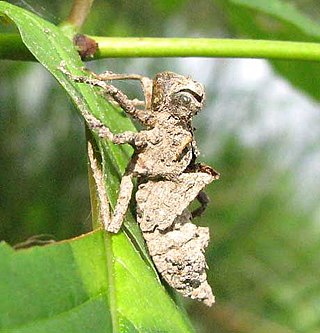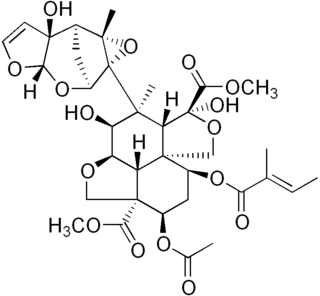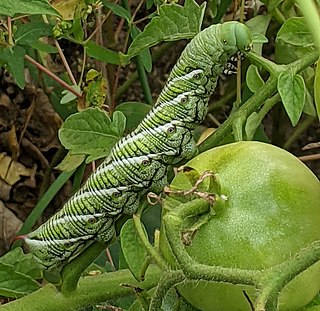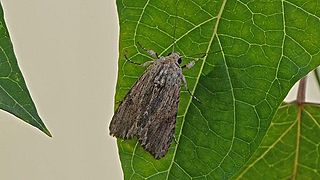Related Research Articles

Azadirachta indica, commonly known as neem, margosa, nimtree or Indian lilac, is a tree in the mahogany family Meliaceae. It is one of two species in the genus Azadirachta. It is native to the Indian subcontinent and to parts of Southeast Asia, but is naturalized and grown around the world in tropical and subtropical areas. Its fruits and seeds are the source of neem oil. Nim (नीम) is a Hindustani noun derived from Sanskrit nimba (निंब).

An exoskeleton is an external skeleton that both supports the body shape and protects the internal organs of an animal, in contrast to an internal endoskeleton which is enclosed under other soft tissues. Some large, hard protective exoskeletons are known as "shells".

Azadirachtin, a chemical compound belonging to the limonoid group, is a secondary metabolite present in neem seeds. It is a highly oxidized tetranortriterpenoid which boasts a plethora of oxygen-bearing functional groups, including an enol ether, acetal, hemiacetal, tetra-substituted epoxide and a variety of carboxylic esters.

A pupa is the life stage of some insects undergoing transformation between immature and mature stages. Insects that go through a pupal stage are holometabolous: they go through four distinct stages in their life cycle, the stages thereof being egg, larva, pupa, and imago. The processes of entering and completing the pupal stage are controlled by the insect's hormones, especially juvenile hormone, prothoracicotropic hormone, and ecdysone. The act of becoming a pupa is called pupation, and the act of emerging from the pupal case is called eclosion or emergence.

Limonoids are phytochemicals of the triterpenoid class which are abundant in sweet or sour-scented citrus fruit and other plants of the families Cucurbitaceae, Rutaceae, and Meliaceae. Certain limonoids are antifeedants such as azadirachtin from the neem tree.

Manduca sexta is a moth of the family Sphingidae present through much of the Americas. The species was first described by Carl Linnaeus in his 1763 Centuria Insectorum.

Neem oil, also known as margosa oil, is a vegetable oil pressed from the fruits and seeds of the neem, a tree which is indigenous to the Indian subcontinent and has been introduced to many other areas in the tropics. It is the most important of the commercially available products of neem, and its chemical properties have found widespread use as a pesticide in organic farming.

Melia azedarach, commonly known as the chinaberry tree, pride of India, bead-tree, Cape lilac, syringa berrytree, Persian lilac, Indian lilac, or white cedar, is a species of deciduous tree in the mahogany family, Meliaceae, that is native to Indomalaya and Australasia.

Snakeflies are a group of predatory insects comprising the order Raphidioptera with two extant families: Raphidiidae and Inocelliidae, consisting of roughly 260 species. In the past, the group had a much wider distribution than it does now; snakeflies are found in temperate regions worldwide but are absent from the tropics and the Southern Hemisphere. Recognisable representatives of the group first appeared during the Early Jurassic. They are a relict group, having reached their apex of diversity during the Cretaceous before undergoing substantial decline.
The Barton–McCombie deoxygenation is an organic reaction in which a hydroxy functional group in an organic compound is replaced by a hydrogen to give an alkyl group. It is named after British chemists Sir Derek Harold Richard Barton and Stuart W. McCombie.
Neem cake organic manure is the by-product obtained in the process of cold pressing of neem tree fruits and kernels, and the solvent extraction process for neem oil cake. It is a potential source of organic manure under the Bureau of Indian Standards, Specification No. 8558. Neem has demonstrated considerable potential as a fertilizer. For this purpose, neem cake and neem leaves are especially promising. Puri (1999), in his book on neem, has given details about neem seed cake as manure and nitrification inhibitor. The author has described that, after processing, neem cake can be used for partial replacement of poultry and cattle feed.

The African armyworm, also called okalombo, kommandowurm, or nutgrass armyworm, is a species of moth of the family Noctuidae. The larvae often exhibit marching behavior when traveling to feeding sites, leading to the common name "armyworm". The caterpillars exhibit density-dependent polyphenism where larvae raised in isolation are green, while those raised in groups are black. These phases are termed solitaria and gregaria, respectively. Gregaria caterpillars are considered very deleterious pests, capable of destroying entire crops in a matter of weeks. The larvae feed on all types of grasses, early stages of cereal crops, sugarcane, and occasionally on coconut. The solitaria caterpillars are less active and undergo much slower development. The species is commonly found in Africa, but can also be seen in Yemen, some Pacific islands, and parts of Australia. African armyworm outbreaks tend to be devastating for farmland and pasture in these areas, with the highest-density outbreaks occurring during the rainy season after periods of prolonged drought. During the long dry seasons ("off-season"), the population densities are very low and no outbreaks are seen.

Spodoptera littoralis, also referred to as the African cotton leafworm or Egyptian cotton leafworm or Mediterranean brocade, is a species of moth in the family Noctuidae. S. littoralis is found widely in Africa, Mediterranean Europe and Middle Eastern countries. It is a highly polyphagous organism that is a pest of many cultivated plants and crops. As a result, this species was assigned the label of A2 quarantine pest by the EPPO and was cautioned as a highly invasive species in the United States. The devastating impacts caused by these pests have led to the development of both biological and chemical control methods. This moth is often confused with Spodoptera litura.

Spodoptera eridania is a moth that is known to be a pest. They are one of the most important defoliators in the tropical and subtropical regions of the western hemisphere that feed heavily on plants while they are young, often resulting in skeleton leaves on their food plants. They are also heavy feeders on tomato in Florida. There is a lot of development in producing pesticides against the S. eridania, specifically a neem-based pesticide that can result in smaller and prolonged development. The wingspan is 33–38 mm. Adults are on wing year-round. The larvae feed on various weeds but prefer Amaranthus species and Phytolacca americana.
An insect growth regulator (IGR) is a substance (chemical) that inhibits the life cycle of an insect. IGRs are typically used as insecticides to control populations of harmful insect pests such as cockroaches and fleas.

Euproctis melanosoma is a species of moth of the family Erebidae. It is known from New South Wales, Queensland, Tasmania and Victoria.

Nimbin is a triterpenoid isolated from Neem. Nimbin is thought to be responsible for much of the biological activities of neem oil, and is reported to have anti-inflammatory, antipyretic, fungicidal, antihistamine and antiseptic properties.

The South American palm weevil, Rhynchophorus palmarum, is a species of snout beetle. The adults are relatively large black beetles of approximately one and a half inch in length, and the larvae may grow to two inches in length.
Tuticorin Raghavachari Govindachari FNA, FASc (1915–2001), popularly known as TRG, was an Indian natural product chemist, academic, institution builder and the principal of Presidency College, Chennai. He was known for his studies on the synthesis of isoquinolines and phenanthridines and his contributions in elucidating the structure of several plant constituents. He was an elected fellow of the Indian Academy of Sciences and the Indian National Science Academy and was the nominator of Robert Burns Woodward who won the 1965 Nobel Prize in Chemistry. The Council of Scientific and Industrial Research, the apex agency of the Government of India for scientific research, awarded him the Shanti Swarup Bhatnagar Prize for Science and Technology, one of the highest Indian science awards, in 1960, for his contributions to chemical sciences, making him the first recipient of the award in the chemical sciences category.

Polytela gloriosae, the Indian lily moth or lily caterpillar, is a moth of the family Noctuidae. The species was first described by Johan Christian Fabricius in 1781. It is found in Sri Lanka, India and probably in Indonesia.
References
- ↑ "Pesticide Information Profile: Azadirachtin". Extension Toxicology Network. Cornell University. Archived from the original on 29 July 2020.